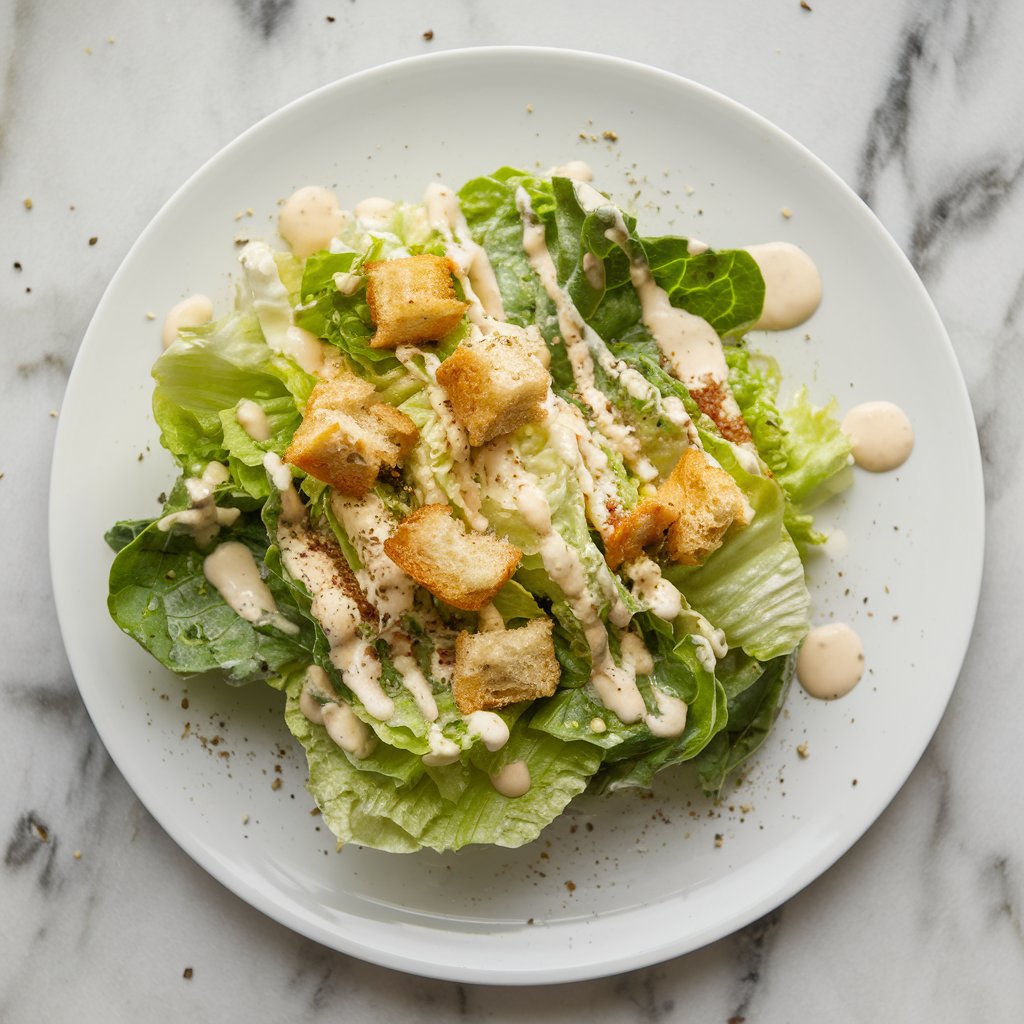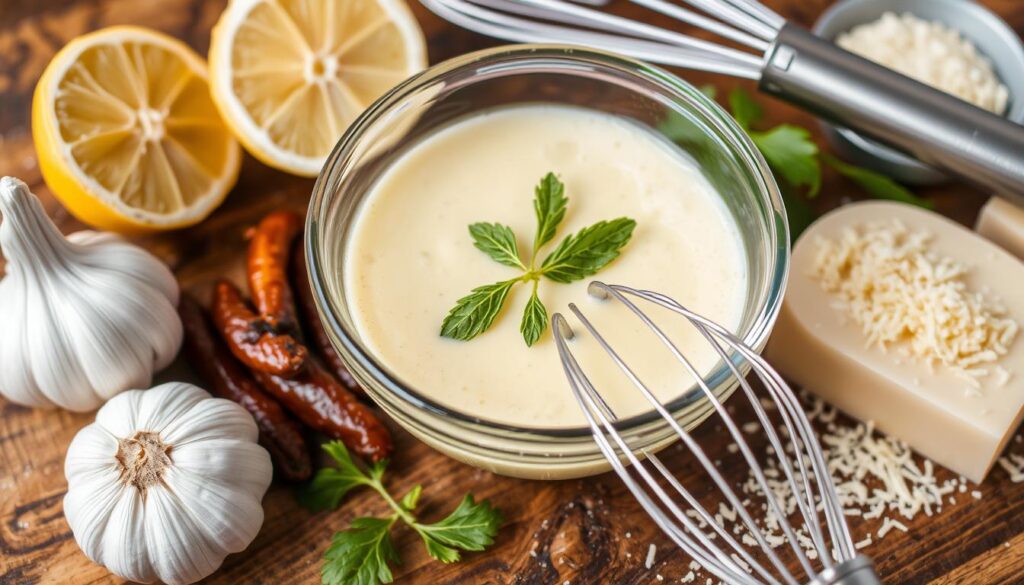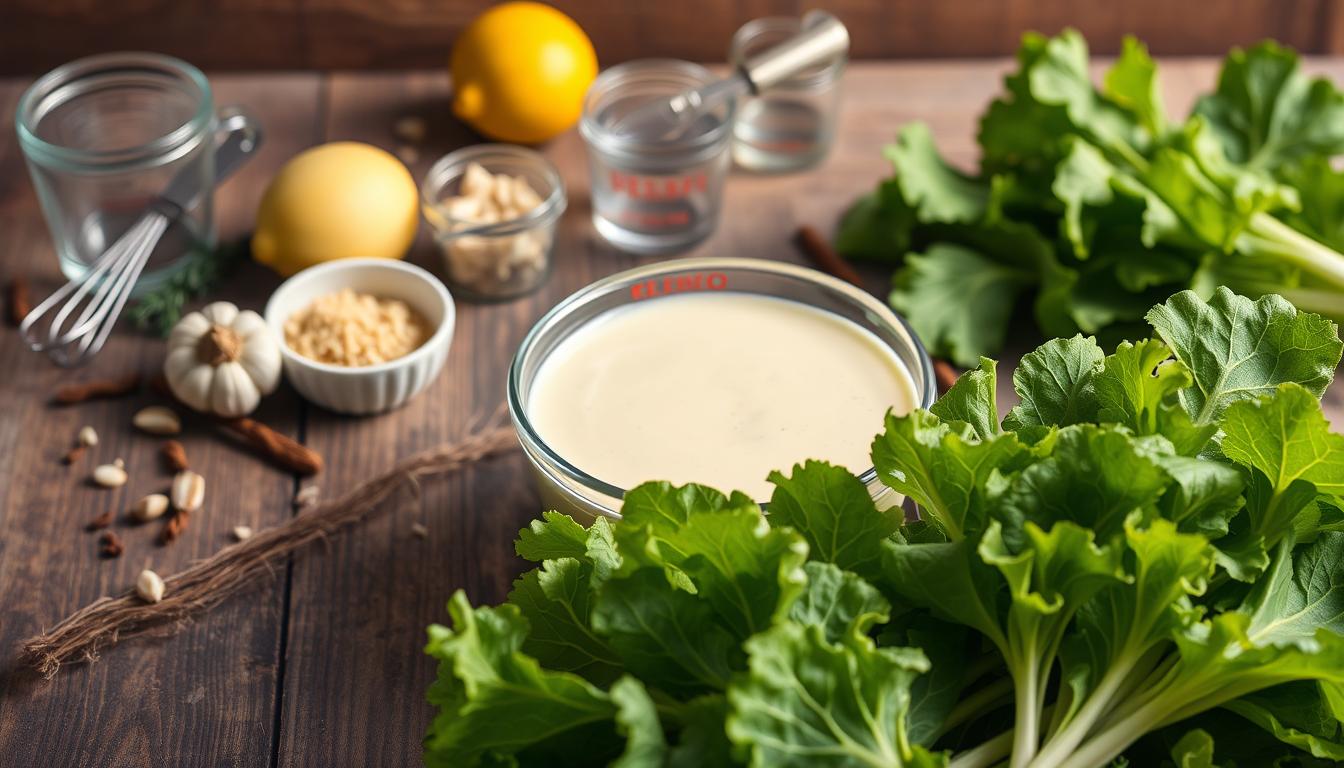Creating a meal from scratch is comforting, bringing back fond memories. As a child, I loved sitting at the dinner table. We shared stories while enjoying fresh salads with creamy Caesar dressing.
Those moments are not just about the food. They’re about family warmth and laughter. Now, making my own cesar salad dressing brings back those feelings. It’s a homemade love that’s rich, creamy, and free from garlic or fish notes found in store-bought versions.
In our fast-paced lives, we often choose convenience over homemade. But making something yourself is different. This recipe is simple, using just a few ingredients and minutes to prepare. It’s great not just for salads but also as a dipping sauce or on grilled meats.
Let’s explore the world of authentic cesar salad dressing. See how it can make your meals better and bring back those special memories.
This dressing is perfect for family dinners or when you have friends over. Once you try it, you might never go back to store-bought again. It’s time to add homemade warmth to your table!

- Introduction to Caesar Salad Dressing
- Why Choose Homemade Caesar Salad Dressing
- Key Ingredients for an Authentic Caesar Salad Dressing
- Step-by-Step Instructions for Making Caesar Salad Dressing
- Variations on the Classic Caesar Salad Dressing Recipe
- Tips for Perfecting Your Caesar Salad Dressing
- Storing Your Homemade Caesar Salad Dressing
- Serving Suggestions with Your Caesar Salad Dressing
- Health Benefits of Homemade Caesar Salad Dressing
- Delicious Salad Pairings for Your Homemade Dressing
- Conclusion
- Source Links
Introduction to Caesar Salad Dressing
Caesar salad dressing is a key part of both home cooking and restaurant menus. It adds a creamy texture and bold flavors, making it more than just a salad topping. Its history goes back to the early 1900s, with roots in Italian-American cuisine.
When I think of Caesar salad dressing, I see its creamy texture and how it pairs with lettuce and croutons. Making it at home lets me choose the best ingredients for a fresher taste. Whether it’s for a family dinner or a party, homemade dressing makes the salad better.
This dressing is loved for its versatility. I use it in salads, as a dip, or sauce for other dishes. The mix of ingredients makes every bite special. Making it myself ensures it’s always fresh and of high quality.
| Nutritional Information | Per Serving (8 servings) |
|---|---|
| Calories | 203 |
| Fat | 20.4 g (31.4%) |
| Saturated Fat | 2.5 g (12.5%) |
| Carbohydrates | 1.7 g (0.6%) |
| Fiber | 0.4 g (1.5%) |
| Sugars | 0.3 g |
| Protein | 4.1 g (8.2%) |
| Sodium | 297.9 mg (12.4%) |
Choosing to make my own dressing lets me try different recipes and keep things healthy. As I play with flavors, I learn more about Caesar salad dressing. This journey improves my cooking and makes meals more enjoyable.
Why Choose Homemade Caesar Salad Dressing
Making my own Caesar salad dressing has many benefits. It tastes fresher than store-bought versions because it doesn’t have artificial preservatives. This recipe mixes ½ cup mayonnaise, ¼ cup extra-virgin olive oil, and 2 tablespoons fresh lemon juice. It gives salads a vibrant flavor.
By making it myself, I can choose healthier ingredients. I can adjust the salt and add things like Worcestershire sauce or vegetarian Parmesan cheese. This way, I avoid too much sodium and artificial flavors found in store-bought dressings.
Making the dressing is easy. A mix of 1 cup mayonnaise with other ingredients makes about 1.5 cups of dressing. It’s perfect for several salads. I get 4 generous side salads or 6 small salads from one batch. The dressing stays fresh in the fridge for up to 5 days.
My homemade Caesar salad dressing is clean, healthy, and customizable. It’s a better choice than commercial dressings. I enjoy making it and tailoring it to my taste. For more insights, check out my dressing choices.
| Ingredient | Measurement | Purpose |
|---|---|---|
| Mayonnaise | ½ cup | Base for creaminess |
| Extra-virgin olive oil | ¼ cup | Healthy fat source |
| Fresh lemon juice | 2 tablespoons | Adds brightness |
| Dijon mustard | 2 teaspoons | Enhances flavor depth |
| Garlic | 1 clove | Bold flavor element |
| Worcestershire sauce | ½ teaspoon | Umami character |
| Parmesan cheese | ⅓ cup | Salty richness |
| Fine salt | ⅛ teaspoon | Balances flavors |
| Black pepper | To taste | Spices up the dressing |
Key Ingredients for an Authentic Caesar Salad Dressing
Making an authentic Caesar salad dressing needs the right ingredients. Each one is important for the dressing’s rich taste and creamy feel. These ingredients make the dressing a classic favorite.
Essential Ingredients for the Dressing
The base of a real Caesar salad dressing includes:
- 6 anchovies in oil, adding a deep flavor
- 2 egg yolks for creaminess
- 3 garlic cloves, bringing strong taste
- 1/4 cup freshly squeezed lemon juice, for a bright note
- 2 teaspoons Dijon mustard, for a slight tang
- 1/2 cup extra-virgin olive oil, to make it richer
- 1/2 cup grated Parmesan cheese, for a savory end
This mix not only boosts the flavor but also keeps calories low. This way, you can enjoy it without feeling guilty.
Choosing the Right Parmesan Cheese
The type of cheese you choose is key for a true Caesar salad dressing. I suggest using imported Parmigiano-Reggiano over domestic Parmesan. It makes a big difference in taste, making the dressing richer and more complex.
The Role of Anchovy Paste
Anchovy paste is a key ingredient in many Caesar salad dressings. It’s a great option for those who don’t like whole anchovies. You can use 1/2 teaspoon of paste for every 1 anchovy fillet. This makes it easy to get that classic taste without any fuss.
Step-by-Step Instructions for Making Caesar Salad Dressing
Making homemade Caesar salad dressing is fun and easy. I’ll show you how to make that classic Caesar salad dressing flavor. Follow these steps, and you’ll have a delicious dressing for your favorite greens in no time.
Step 1: Preparing the Garlic and Anchovy Paste
Start by mincing 2 cloves of garlic. Then, mix them with 4 anchovies in a small bowl. Use a fork to mash them until smooth. This paste is key to the dressing’s bold flavor.
Step 2: Mixing the Dressing Ingredients
In a bowl, combine the garlic-anchovy paste with ½ tablespoon Dijon mustard, 1 tablespoon Worcestershire sauce, and 3 tablespoons of fresh lemon juice. Add ½ cup of mayonnaise and ¾ cup of Parmigiano-Reggiano. Whisk until everything is well mixed.
Step 3: Achieving the Right Consistency
To get the right consistency, slowly add ¾ cup of extra virgin olive oil while whisking. This makes the dressing creamy. Add salt and pepper to taste, adjusting as needed. You’ll end up with a rich, creamy dressing that makes any salad better.

Variations on the Classic Caesar Salad Dressing Recipe
Exploring different Caesar salad dressing recipes adds a fun twist to a classic favorite. There are many ways to change the traditional recipe. This can be to fit dietary needs or to add some creativity. Here are a few popular changes to try.
Egg-Free Options for Caesar Dressing
For those who don’t like raw eggs, there are egg-free versions. You can use mayonnaise or silken tofu for a creamy texture. These options keep the dressing rich but make it safe for everyone.
Creating a Vegan Version
A vegan Caesar salad dressing is a great alternative. By swapping out typical ingredients for plant-based ones, you can use plant-based mayonnaise. You can also replace anchovies with capers. This version respects vegan choices and offers a new flavor that goes well with the salad.
Adjusting the Flavor Profile
Adding spices or herbs can make any Caesar salad dressing your own. Try smoked paprika, Dijon mustard, or fresh herbs to change the taste. These changes let you create a dressing that suits your taste perfectly.
Tips for Perfecting Your Caesar Salad Dressing
Making the best Caesar salad dressing is more than just a recipe. Let the dressing sit for a few hours to blend the flavors. This step makes the dressing taste richer and more delicious.
Adjusting garlic and lemon juice to your taste is important. Everyone likes different flavors. Adding freshly grated Parmesan cheese makes it creamier and more flavorful. Using fresh ingredients makes the dish better.
Trying different oils can make the dressing more interesting. While olive oil is classic, avocado or nut oils add richness. Remember, balance is key to a great dressing. Adjust the ingredients as needed.

- Let the dressing rest for a few hours.
- Adjust garlic and lemon juice to taste.
- Use freshly grated Parmesan cheese.
- Try different oils for added richness.
- Ensure the right balance of all ingredients.
For more tips on making the best Caesar salad dressing, check out this resource. It has a great recipe and helpful tips.
Storing Your Homemade Caesar Salad Dressing
Keeping your homemade Caesar salad dressing fresh is key. Proper storage helps it stay good for longer. It also keeps it safe to eat.
How Long It Lasts in the Fridge
Homemade Caesar salad dressing can last up to a week in the fridge. If you use garlic powder instead of fresh garlic, it can last up to two weeks. This keeps the dressing tasty for longer.
Best Practices for Storing
To keep your salad dressing at its best, follow these tips:
- Use a clean, airtight container to stop bacteria growth.
- Mark the container with a date to remember when it’s fresh.
- Keep it in the fridge’s coldest spot, away from the door.
- Don’t open and close the container too much to avoid bacteria.
By storing your Caesar salad dressing this way, you can enjoy its great taste. You’ll also know it’s safe and of high quality.
| Ingredient | Storage Recommendation | Shelf Life |
|---|---|---|
| Garlic Powder | Airtight container | Indefinitely |
| Mayonnaise | Fridge, tightly sealed | Up to 2 months |
| Anchovies | Airtight container in fridge | Up to 1 year |
| Lemon Juice | Fridge | Up to 1 week after opening |
| Parmesan Cheese | Fridge, wrapped | Up to 1 month |

Serving Suggestions with Your Caesar Salad Dressing
When serving Caesar salad dressing, the classic choice is crisp romaine lettuce. This mix offers a refreshing crunch and a perfect base for the dressing’s rich flavors. I also like to add other greens like arugula or mixed greens for extra depth. Fresh veggies like cucumber, cherry tomatoes, or bell peppers can make any salad better.
Pairing with Fresh Romaine Lettuce
A traditional Caesar salad uses romaine lettuce. I suggest using about 20 ounces of fresh, crisp romaine for a big salad. This salad can serve up to 4 large portions or 8 smaller ones. The creamy dressing and crisp lettuce make a perfect pair.
Adding Protein: Grilled Chicken and More
To make the meal more substantial, add proteins like grilled chicken or shrimp. These make the salad a complete meal. For a vegetarian option, try roasted chickpeas for a satisfying crunch. My grilled lemon herb chicken recipe pairs well with Caesar salad dressing.
Adding these ingredients to Caesar salad dressing makes any salad a culinary delight. Try different combinations to find your favorite!
Health Benefits of Homemade Caesar Salad Dressing
Making Caesar salad dressing at home lets me use fresh, quality ingredients. This way, I can avoid too much sodium and artificial additives found in store-bought versions. I get to make a healthier version that’s full of flavor.
Romaine lettuce is a key ingredient, full of fiber, folate, Vitamin C, and Vitamin K. These nutrients are good for your eyes, help with blood clotting, and have anti-inflammatory effects. Anchovies add omega-3 fatty acids, which are great for your heart and reducing inflammation.
Parmesan cheese is another important part, rich in protein and calcium. It’s low in lactose, making it good for those who can’t digest lactose well. It also has probiotics, which are good for your gut. The olive oil in the dressing is full of healthy fats that can lower bad cholesterol and help your heart.
Adding beans to the dressing can make it even healthier. Beans are full of fiber and folate, which help with weight management and gut health. I like to use white beans instead of raw eggs to make it safer and more nutritious.
Choosing whole wheat croutons instead of white bread adds more nutrition to my salad. It’s tempting to use a lot of olive oil, but using it wisely helps keep calories in check.
Switching to fat-free Greek yogurt instead of mayonnaise is a big plus. Greek yogurt has fewer calories, less fat, and more protein than mayonnaise. Making these changes makes my Caesar salad dressing healthier and more enjoyable. For more on Caesar salad nutrition, check out this resource.
Delicious Salad Pairings for Your Homemade Dressing
Creating the perfect salad pairings for Caesar dressing can elevate your meal experience significantly. My homemade dressing complements a variety of salads, from the classic preparation to some creative seasonal ideas.
Classic Caesar Salad with Croutons
When I think of salad pairings for Caesar dressing, the classic Caesar salad comes to mind immediately. This timeless dish typically features:
- 1 head of Romaine lettuce, torn into bite-sized pieces
- 1/4 cup grated Parmesan or Romano cheese
- Crunchy croutons for added texture
- A drizzle of my creamy homemade Caesar dressing
With the combination of crisp greens, salty cheese, and delicious dressing, this is a winning combination every time. The process is fairly simple and perfect for any home cook.
Creative Seasonal Salad Ideas
For a twist on tradition, you can explore various salad pairings for Caesar dressing that bring in seasonal flavors. Some delightful options include:
- Roasted vegetables like butternut squash and Brussels sprouts
- A bed of mixed seasonal greens topped with sliced apples or pears
- Grilled proteins such as chicken, shrimp, or steak
- Toasted nuts for an extra crunch
These innovative salads not only work harmoniously with the dressing but also showcase its versatility. Feel free to mix and match ingredients based on what’s available and in season.
| Salad Type | Main Ingredients | Serving Suggestions |
|---|---|---|
| Classic Caesar Salad | Romaine lettuce, croutons, Parmesan cheese, Caesar dressing | Enjoy as a side dish or add grilled chicken for a meal |
| Seasonal Roasted Veg Salad | Roasted butternut squash, Brussels sprouts, mixed greens | Ideal for fall; pair with toasted walnuts |
| Grilled Protein Salad | Grilled chicken, shrimp, or steak over greens | Perfect for a light dinner or lunch |
Conclusion
Making your own Caesar salad dressing can change how you enjoy food. Using high-quality ingredients like mayo, garlic, and Parmesan cheese lets you customize the taste. You can choose to keep it vegetarian or add anchovy paste for a unique flavor.
This personal touch makes your salad dressing special. It brings out the best in fresh greens and proteins. You can serve it to up to six people, making it perfect for gatherings.
For more details, check out the cesar salad dressing recipe. It includes tips on how to prepare and store it. The dressing can stay fresh in the fridge for a few days.
This recipe is quick to make, even on busy days. It has been shared 28 times on social media. It shows that you can have gourmet flavors at home easily.
Trying homemade Caesar dressing is a simple way to improve your cooking. It invites you to be creative and try new things. I suggest everyone give it a try. Enjoy making delicious, customized salads for any occasion.
Source Links
- Homemade Caesar Salad Dressing – Once Upon a Chef – https://www.onceuponachef.com/recipes/caesar-salad-dressing.html
- Best Caesar Salad Dressing – https://www.inspiredtaste.net/46604/caesar-salad-dressing/
- “This is PERFECTION,” Says Everyone Who’s Made This Caesar Salad Dressing – https://www.thekitchn.com/how-to-make-the-best-caesar-dressing-233883
- Caesar Salad Dressing — Kendall Andronico – https://www.kendallandronico.com/all-recipes/caesar-salad-dressing
- Easy Caesar Dressing – https://cookieandkate.com/caesar-dressing-recipe/
- This Easy Homemade Caesar Dressing Is WAY Better Than Store-Bought (Just 9 Ingredients!) – https://www.loveandlemons.com/caesar-dressing/
- Homemade Caesar Salad – https://cookieandkate.com/caesar-salad-recipe/
- Healthy Homemade Caesar Salad Dressing (Dairy Optional) – https://wellnessmama.com/recipes/caesar-dressing-recipe/
- Authentic Caesar Dressing – The Recipe Critic – https://therecipecritic.com/caesar-dressing/
- Original Caesar Salad Dressing Recipe – https://www.foodbymaria.com/caesar-salad-dressing-recipe/
- Classic Caesar Salad Recipe – Foolproof Living – https://foolproofliving.com/classic-caesar-salad/
- Traditional Caesar Dressing – Always From Scratch – https://alwaysfromscratch.com/traditional-caesar-dressing/
- Easy Caesar Dressing Recipe (VIDEO) – https://natashaskitchen.com/perfect-ceasar-dressing-recipe/
- 19 Caesar Salad Recipes From Classic to Reimagined – https://www.foodandwine.com/caesar-salad-recipes-8676280
- I Make This Caesar Salad Recipe On Repeat (It’s SO Delicious!) – https://www.loveandlemons.com/caesar-salad/
- The Best Caesar Salad Recipe – https://www.seriouseats.com/the-best-caesar-salad-recipe
- Perfect Caesar Salad with the Best Caesar Dressing – https://www.andiemitchell.com/perfect-caesar-salad-with-the-best-caesar-dressing/
- Make the Homemade Caesar Dressing at Home — in Just 5 Minutes! – https://www.culinaryhill.com/homemade-caesar-salad-dressing/
- Homemade Caesar Salad Dressing – Healthy Seasonal Recipes – https://www.healthyseasonalrecipes.com/creamy-classic-caesar-salad-dressing/
- Homemade Caesar Dressing Recipe – https://www.killingthyme.net/homemade-caesar-dressing-recipe/
- Homemade Caesar Salad Dressing – Evolving Table – https://www.evolvingtable.com/caesar-salad-dressing/
- The BEST Caesar Salad Recipe! | Gimme Some Oven – https://www.gimmesomeoven.com/best-caesar-salad/
- Caesar Salad – https://www.spendwithpennies.com/caesar-salad/
- How to Make a Healthier Caesar Salad – https://www.webmd.com/food-recipes/how-to-make-healthier-caesar-salad
- Healthy Greek Yogurt Caesar Dressing – No Anchovies – https://www.healthy-delicious.com/greek-yogurt-caesar-dressing/
- Caesar Salad with Homemade Croutons – Living The Gourmet – https://livingthegourmet.com/2024/05/caesar-salad-with-homemade-croutons.html
- Steakhouse Style Homemade Caesar Dressing – https://aflavorjournal.com/steakhouse-caesar-dressing-for-two/
- Kid Friendly Caesar Salad – Marin Mama Cooks – https://marinmamacooks.com/kid-friendly-caesar-salad/
- Scratch Made Caesar Dressing : Anchovy Free Recipe – Vegetarian – https://grainsinsmallplaces.net/caesar-dressing-vegetarian/
- Best Basic Caesar Salad Recipe – https://www.foodrepublic.com/recipes/best-basic-caesar-salad-recipe/

